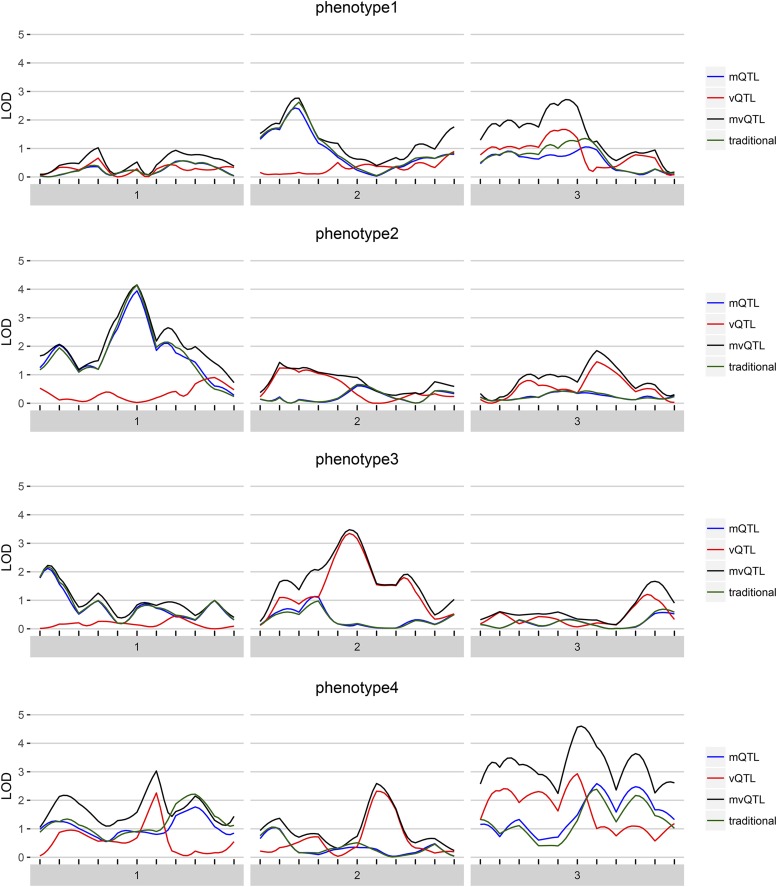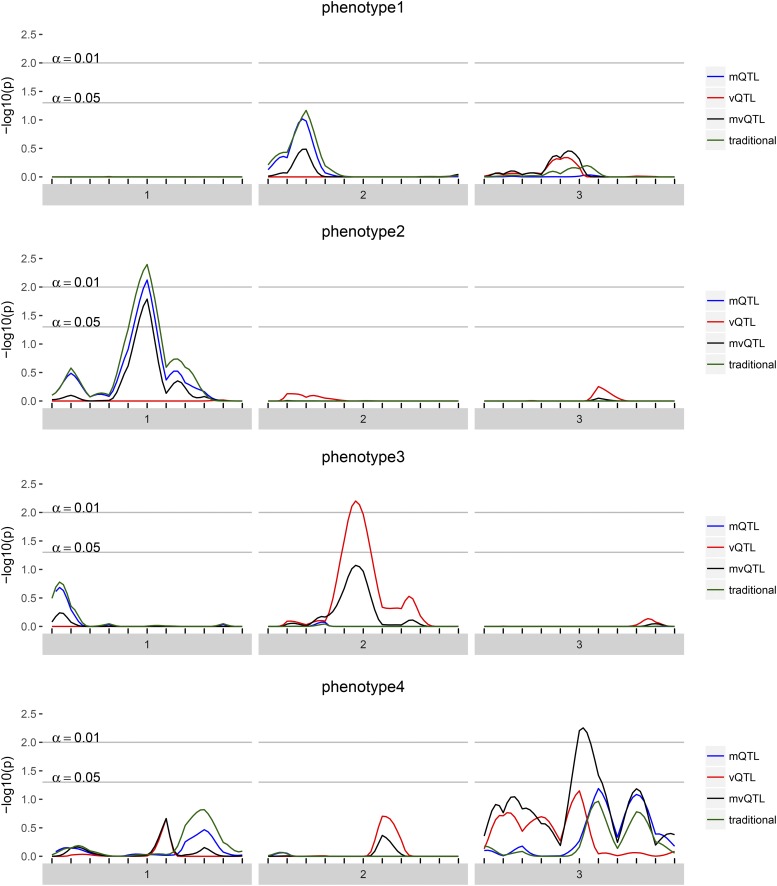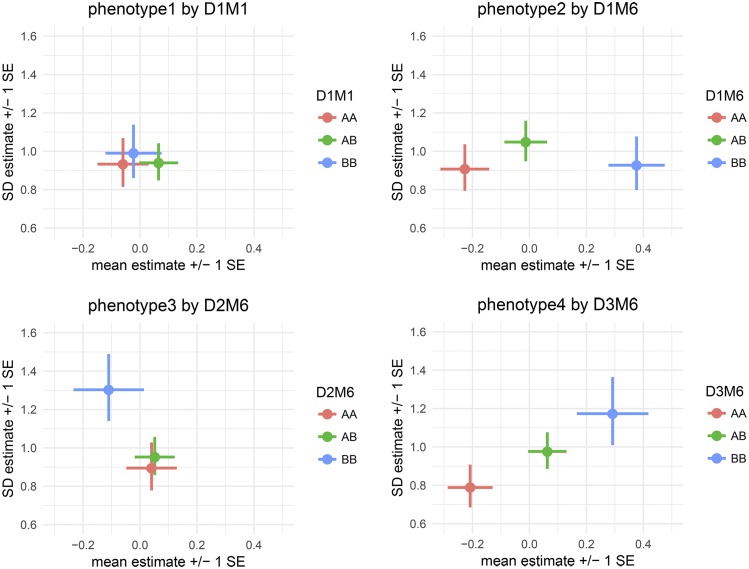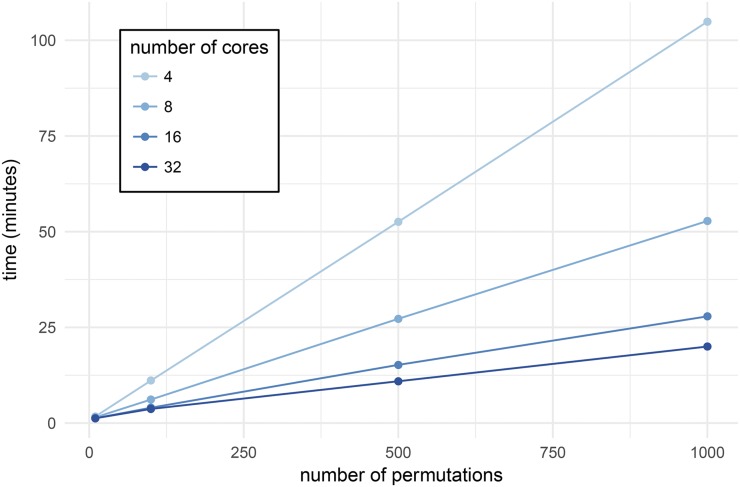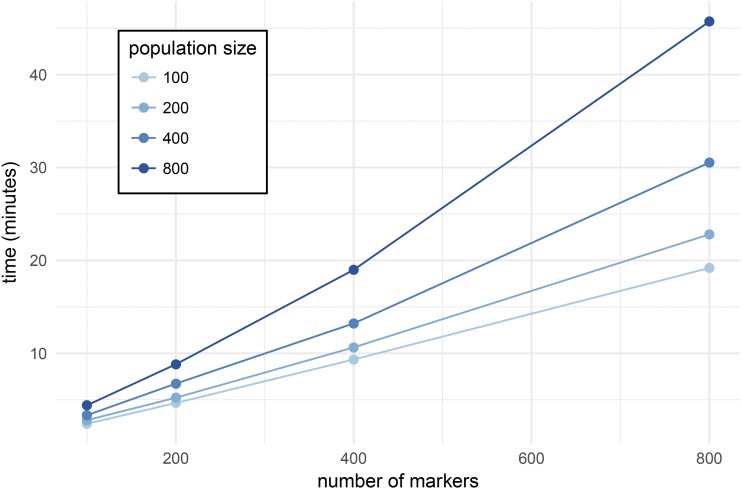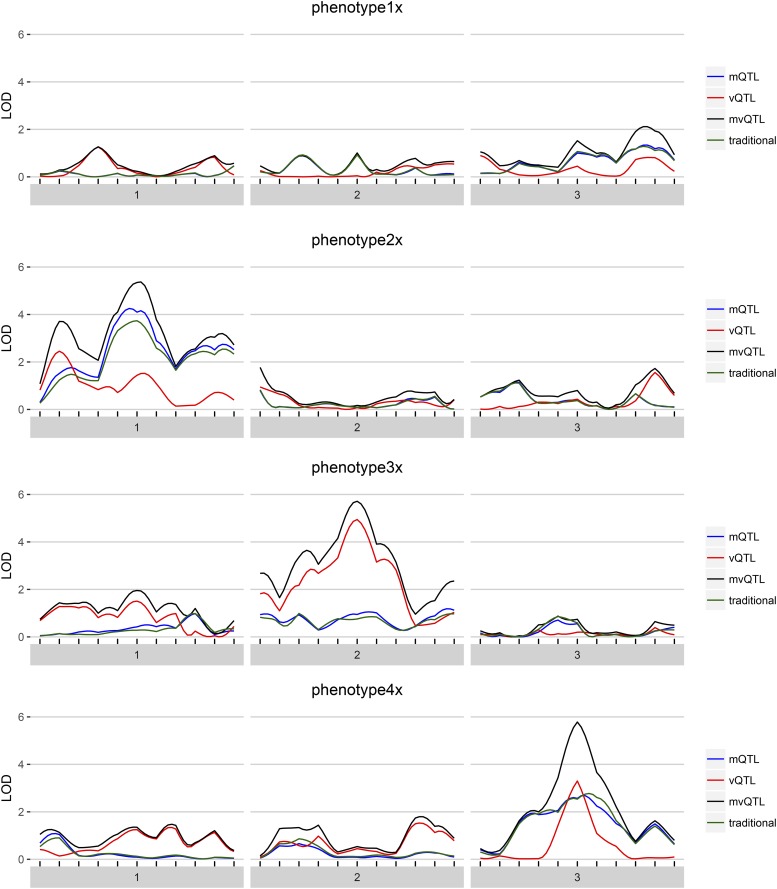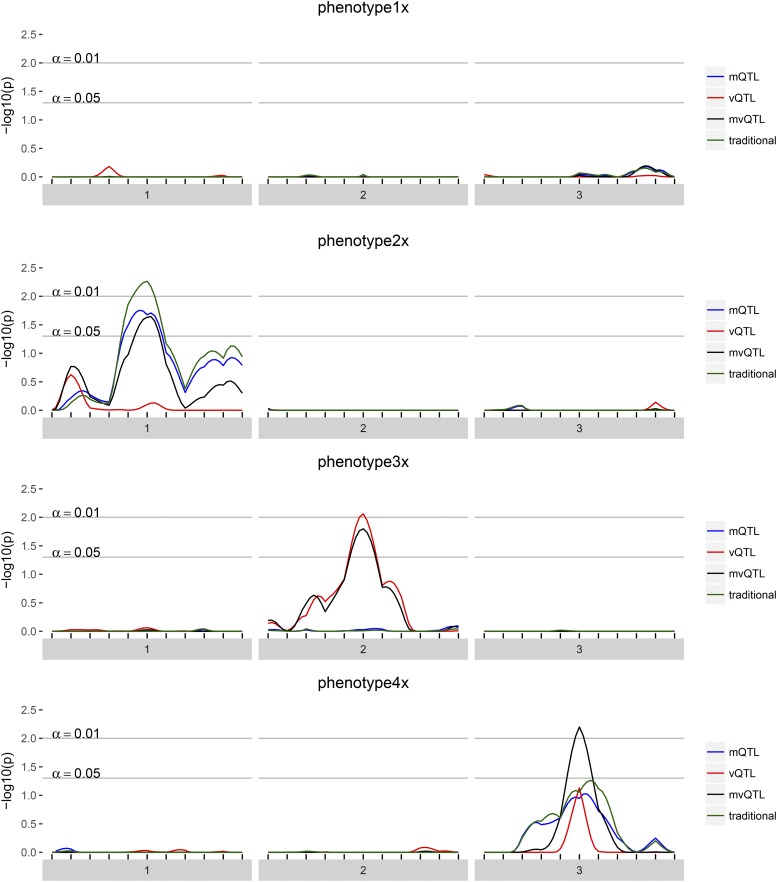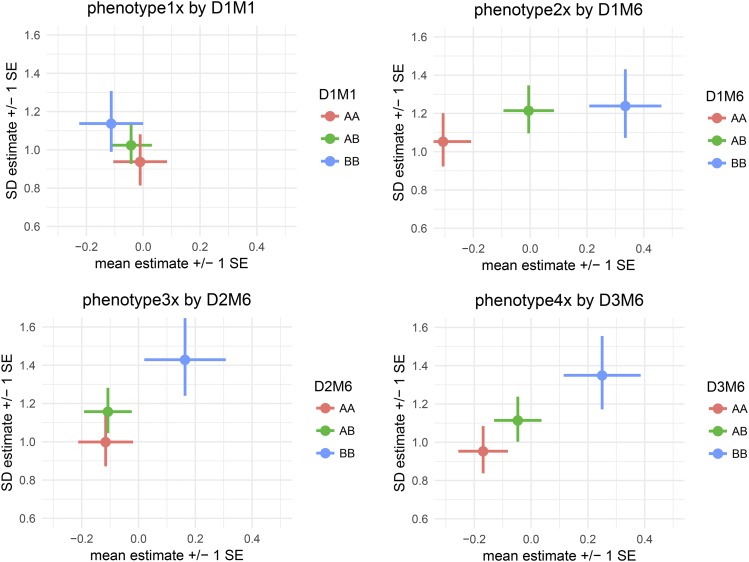Abstract
We present vqtl, an R package for mean-variance QTL mapping. This QTL mapping approach tests for genetic loci that influence the mean of the phenotype, termed mean QTL, the variance of the phenotype, termed variance QTL, or some combination of the two, termed mean-variance QTL. It is unique in its ability to correct for variance heterogeneity arising not only from the QTL itself but also from nuisance factors, such as sex, batch, or housing. This package provides functions to conduct genome scans, run permutations to assess the statistical significance, and make informative plots to communicate results. Because it is inter-operable with the popular qtl package and uses many of the same data structures and input patterns, it will be straightforward for geneticists to analyze future experiments with vqtl as well as re-analyze past experiments, possibly discovering new QTL.
Keywords: heteroscedastic regression, mvQTL; variance heterogeneity; DGLM
Traditional quantitative trait locus (QTL) analyses have focused on discovering “mean QTL” (mQTL), regions of the genome where allelic variation drives heterogeneity of phenotype mean, while assuming that the residual variance, that is, the intrinsic stability or noisiness of the phenotype, is identical for every individual in the mapping population. It has long been recognized, however, that the residual variance is itself heritable (Falconer 1965; Lynch and Walsh 1998), a phenomenon that has been described theoretically (Hill and Zhang 2004; Hill and Mulder 2010), demonstrated in inbred model organisms (Sorensen et al. 2015) and crops (Yang et al. 2012), and exploited in livestock improvement efforts (Mulder et al. 2008; Ibáñez-Escriche et al. 2008). Correspondingly, several groups have proposed statistical methods for mapping QTL controlling the extent of this residual variance, these sometimes termed “variance QTL” (vQTL) (Paré et al. 2010; Rönnegård and Valdar 2011, 2012; Cao et al. 2014; Soave and Sun 2017; Dumitrascu et al. 2018). Nonetheless, although detection of vQTL has started to enter the mainstream of genetic analysis (Yang et al. 2012; Hulse and Cai 2013; Ayroles et al. 2015; Forsberg et al. 2015; Wei et al. 2016; Wang and Payseur 2017; Wei et al. 2017), statistical tools for this purpose remain heterogeneous.
We have developed a standardized method for QTL mapping in experimental crosses, in particular F2 intercrosses and backcrosses, that simultaneously models mean and variance effects in order to detect mQTL, vQTL and a generalization of the two that we term “mvQTL”. Our approach, which we term “mean-variance QTL mapping”, is based on a double generalized linear model (DGLM) (Smyth 1989), following the proposed use in this context by Rönnegård and Valdar (2011). In the first of two companion articles, we characterize the method and competitors in the setting where variance heterogeneity is driven by a background factor, such as sex, batch or housing, and show that modeling these (external) variance effects improves power to detect mQTL, vQTL and mvQTL (Corty and Valdar 2018). In the second companion paper, we demonstrate the approach on two existing datasets and discover new mQTL and vQTL (Corty et al. 2018).
Here, we provide a practical guide to the approach using its associated R package vqtl, which is currently suitable for F2 intercrosses and backcrosses, and is inter-operable with the well-established mean QTL-oriented package for this purpose, r/qtl (Broman et al. 2003). First, to generate illustrative data, we simulate an F2 intercross and four phenotypes: one phenotype determined entirely by random noise, and one with each of the three kinds of QTL. On each phenotype we then conduct a genome scan using standard approximations to interval mapping (Lander and Botstein 1989; Haley and Knott 1992; Martínez and Curnow 1992), and mean-variance QTL mapping, which includes a test for mQTL, a test for vQTL, and a test for mvQTL. The association statistics of all four tests are initially plotted in LOD score units, with drawbacks of this plotting unit discussed; then permutation scans are used to determine empirically-adjusted p-values, and plotting in these units is shown to to make the results of the four tests more easily comparable. Plots are then described that communicate effects that led to the QTL’s detection, and the bootstrap is used to estimate its confidence interval. Last, we benchmark performance, using one of the datasets examined in Corty et al. (2018) to report how computation time varies with marker density and number of permutations.
Example data: Simulated F2 Intercross
To illustrate the use of the vqtl package, we first simulated an example F2 intercross using the R package qtl (Broman et al. 2003), on which vqtl is based. This cross consisted of 200 male and 200 female F2 offspring, with 3 chromosomes of length 100 cM, each tagged by 11 equally-spaced markers and estimated genotype probabilities at 2cM intervals with qtl’s hidden Markov model. We then generated four phenotypes:
phenotype1 consists only of random noise and will serve as an example of negative results for all tests.
phenotype2 has an mQTL that explains 4% of phenotype variance at the center of chromosome one.
-
phenotype3 has a vQTL at the center of chromosome two.
This vQTL acts additively on the log standard deviation scale, and results in residual standard deviation of [0.8, 1, 1.25] for the three genotype groups.
phenotype4 has an mvQTL at the center of chromosome three. This mvQTL has a mean effect that explains 2.7% of phenotype variance and a variance effect that acts additively on the standard deviation scale, resulting in residual standard deviation of [0.85, 1, 1.17] for the three genotype groups.
We additionally consider phenotype1x through phenotype4x, which have the same type of genetic effects as phenotype1 through phenotype4, but have the additional feature that females have greater residual variance than males. All the same analyses and plots that are shown for phenotype1 through phenotype4 are shown for phenotype1x through phenotype4x in the appendix.
Scan the Genome
The central function for genetic mapping in package qtl is scanone (Broman et al. 2003). Analogously, the central function for mean-variance QTL mapping in package vqtl is scanonevar building on an early version of scanonevar in package r/qtl. It takes three required inputs:
cross is an object that contains the genetic and phenotypic information from an experimental cross, as defined in package r/qtl.
mean.formula is a two-sided formula, specifying the phenotype to be mapped, the covariates to be corrected for, and the QTL terms to be fitted, with keywords mean.QTL.add and mean.QTL.dom
var.formula is a one-sided formula, specifying the variance covariates to be corrected for as well as the QTL terms to be fitted, using keywords var.QTL.add and var.QTL.dom.
For example, to scan a phenotype named p1 we run:
scanonevar(
cross = test_cross,
mean.formula = p1 ∼ sex + mean.QTL.add + mean.QTL.dom,
var.formula = ∼ sex + var.QTL.add + var.QTL.dom
)
At each locus in turn, this function tests for the presence of an mQTL, a vQTL, and an mvQTL. The basis of these tests is a comparison between the fit of an alternative model of the form
with a null model that omits specific terms: for the mQTL test, the null model omits locus effects on phenotype mean; for the vQTL test, the null omits the locus effects on phenotype variance; and for the mvQTL test, the null omits locus effects on both mean and variance. (Note that the mQTL test in mean-variance QTL mapping is different from the traditional test: the traditional test does not have variance predictors of any kind in either null or alternative models.)
LOD scores and nominal p-values
Each type of test (mQTL, vQTL, and mvQTL) yields two association statistics: the LOD score, and the (nominal) p-value. The LOD is a raw measure of association equal to the base 10 logarithm of the likelihood ratio (LR) between the fitted alternative and null models. Higher values indicate greater association when considered across loci for the same type of test; but LOD scores between different types of tests, namely between mvQTL test vs. either mQTL or vQTL tests, are not readily comparable. The p-value, which is comparable between different types of tests, transforms the LOD score to take account of the number of parameters being fit: it is calculated from the asymptotic distribution of under the null model, namely the distribution with degrees of freedom equal to the difference in the number of parameters between the alternative and null models.
The p-values described above, however, are nominal: they do not take into account multiple testing across the genome. They also rely on asymptotic theory that assumes the underlying phenotype being residually normal; this may not always be the case and when violated will lead to inflated significance. More robust p-values that are corrected for genomewide significance via control of the family-wise error rate (FWER) can be obtained empirically, through a permutation procedure described below.
Robust, genomewide-adjusted p-values
To calculate the empirical, FWER-controlled p-value of each test at each locus we advocate use of a permutation procedure (Corty and Valdar 2018). Like previous work on permutation-based thresholds for genetic mapping (Churchill and Doerge 1994; Carlborg and Andersson 2002), this procedure sidesteps the need to explicitly estimate the effective number of tests.
In brief, this approach involves conducting many genomes scans on pseudo-null data generated through permutation to maintain as much of the character of the data as possible, while breaking the tested phenotype-genotype association. Specifically, the design matrix of the QTL is permuted in the mean portion of the mQTL alternative model, the variance portion of the vQTL alternative model, and in both portions of the mvQTL alternative model.
For each test (mQTL, vQTL, and mvQTL), the highest observed test statistic is extracted from each permutation scan and the collection of statistics that results is used to fit a generalized extreme value (GEV) density (Stephenson 2002; Dudbridge and Koeleman 2004; Valdar et al. 2006). The observed LOD scores from the genome scan are then transformed by the cumulative distribution function of the extreme value density to estimate the FWER-controlling p-values. This approach is implemented in the function, scanonevar.perm, which requires two inputs:
sov is the scanonevar object, the statistical significance of which will be assessed through permutation.
n.perms is the number of permutations to conduct.
The object returned by scanonevar.perm is a scanonevar object with two additional pieces of information: an empirical p-value for each test at each locus and the per-permutation maxima that were used to calculate those p-values. These FWER-corrected p-values are straightforwardly interpretable: for a specific test at a specific locus implies that in 5% of similar experiments where there is no true genotype-phenotype association, we would expect to observe some locus with this much or more evidence of association in this test.
Accurate estimation of the FWER-controlled p-values requires many permutation scans: traditionally recommended is 1,000 (e.g., Churchill and Doerge 1994; Carlborg and Andersson 2002), although the efficiency gain of using the GEV rather than raw quantiles means that fewer may be adequate in practice (Valdar et al. 2006). These permutation scans can be run on multiple processors by specifying the optional n.cores argument, which defaults to the total number of cores on the computer minus 2. On an Intel Core i5, running 100 permutations on this dataset takes about five minutes. When many phenotypes are studied, or if faster runtimes are needed, these permutation scans can be broken into groups with different values for random.seed, run on separate computers, and combined with the c function. This function combines the permutations from all the inputted scans, re-estimates the extreme value density, re-evaluates the observed LOD scores in the context of new extreme value density, and returns a new scanonevar object with more precisely estimated empirical p-values.
Reporting and plotting genome scans
The results of scanonevar can be plotted by calling plot on the scanonevar output object. This produces a publication-quality figure that shows the association of the phenotype for each location in the genome as different colors for type of test, with y-axis scale being specified by the user, via option plotting.units as the LOD (Figure 1), nominal p-value, or, provided permutations have been run, empirical, FWER-controlling p-value (Figure 2). Of the available y-axis scales, we recommend using the FWER-controlled p-values since this scale puts all tests on a level-footing (unlike the LOD), and allows direct identification of genomewide significance and thereby relevance (unlike the nominal p-value).
Figure 1.
For each of the four simulated phenotypes, the genome scan shows the LOD score of each test — mQTL, vQTL, and mvQTL — in blue, red, and black, respectively. The traditional test is in green and globally similar to the mQTL test.
Figure 2.
For each of the four simulated phenotypes, the genome scan shows the -log10 of the FWER-corrected p-value for each test — mQTL, vQTL, and mvQTL — in blue, red, and black, respectively. The traditional test is in green and globally similar to the mQTL test. A value of 2 implies that the quantity of evidence against the null is such that we expect to see this much or more evidence once per 100 phenotypes with no true QTL.
Calling summary on the output of scanonevar produces a summary of how the scan was conducted and what the results were.
Communicate Significant Findings
Having identified interesting QTL, we want to visualize the their estimated genetic and covariate effects. Because the vqtl package models effects for both mean and variance, existing plotting utilities are not able to display the entirety of the modeling results. To understand and communicate the results of a vqtl scan at one particular locus, we developed the mean_var_plot. This plot illustrates how the mean sub-model and variance sub-model of the DGLM fit the data at a given locus.
In each mean_var_plot in Figure 3, the location of the dot shows the estimated mean and standard deviation of each genotype group, with the mean indicated by the horizontal position and the standard deviation indicated by the vertical position. The horizontal lines extending to the left and right from each dot show the standard error of the mean estimate, and the vertical lines extending up and down from each dot show the standard error of the standard deviation estimate. There are two types of grouping factors considered by the function mean_var_plot_model_based: (1) focal.groups are groups that are modeled and the prediction for each group is plotted. For example, a genetic marker is the focal.group in each plot in Figure 3; D1M1 in the top left, D1M6 in the top right, D2M6 in the bottom left, and D3M6 in the bottom right. (2) nuisance.groups are groups that are modeled, but then averaged over before plotting. When there are many grouping factors thought to play a role in determining the mean and variance of an individual’s phenotype, such as sex, treatment, and batch, we recommend putting just one or two in focal.groups and the others in nuisance.groups for clarity, cycling through which are displayed to gain a thorough understanding of the factors that influence the phenotype.
Figure 3.
mean_var_plot's show the estimated genotype effects at a locus with mean effects on the horizontal axis and variance effects on the vertical axis. Horizontal lines indicate standard errors for mean effects and vertical lines indicate standard errors for variance effects. For phenotype1, the pattern of overlapping estimates and standard errors is consistent with the fact that there are no genetic effects, and the p-value was not statistically significant at any locus. For phenotype2, the pattern of horizontal, but not vertical, separation visually illustrates the identified mQTL. For phenotype3, the pattern of vertical, but not horizontal, separation visually illustrates the identified vQTL. For phenotype4, the pattern of two-dimensional separation illustrates an mvQTL.
Additional plotting utilities, phenotype_plot, effects_plot mean_var_plot_model_free are described in the online documentation, available on CRAN.
Establish a Confidence Interval for the QTL
Last, to assess the genetic precision of a discovered QTL for bioinformatic follow-up, the function scanonevar.boot estimates confidence intervals via the non-parametric bootstrap (Visscher et al. 1996). This function takes, as arguments, a scanonevar object, the type of QTL detected, the name of the chromosome containing the QTL, and num.resamples, the number of bootstrap resamplings desired. As with scanonevar.perm, the n.cores argument can be used to spread the bootstraps over many computational cores and defaults to the number of cores available minus two, and bootstraps can be run on separate computers and combined with c to increase the precision of the estimate of the confidence interval.
We recommend 1000 resamples to establish 80% and 90% confidence intervals. With the datasets simulated here, it takes 20 min to run 1000 bootstrap resamples on an Intel core i5.
Performance Benchmarks
By far, the most computationally-intensive step in the mean-variance QTL mapping process is the assessment of genome-wide statistical significance by permutation. The original genome scan is much faster, because it involves only a single scan, and the bootstrap is much faster because it involves only a single chromosome.
For the first benchmark, we ran scanonevar.perm on the data from Kumar et al. (2013) and Corty et al. (2018), which contains 244 individuals and 582 loci, varying the number of permutations desired and the number of computer cores used. For a given number of cores, the relationship between time and the number of permutations is linear (Figure 4), the slope depending on the number of cores and ranging from 6.3 sec per permutation with 4 cores to 1.2 sec per permutation with 32 cores.
Figure 4.
Time taken to run scanonevar.perm on the data from Kumar et al. (2013) which contains 244 individuals and 582 loci, varying the number of permutations desired and the number of computer cores used. For a given number of cores, there is a linear relationship between number of permutations conducted and time required. The slope the the line indicates time required per permutation and is dependent on the number of cores, ranging from 6.3 sec per permutation with 4 cores to 1.2 sec per permutation with 32 cores.
For the second benchmark, we ran scanonevar.perm on simulated data, always conducting 1000 permutations and using 32 cores, but varying the number of individuals in the mapping population and the number of markers in the genome. For a given population size, there is a slightly curvilinear relationship between number of markers and time required (Figure 5), which reflects a linear increase in the time taken to conduct the permuted genome scans plus an increase in the time taken for “bookkeeping” tasks like organizing and reshaping genetic data. The slope (minutes per locus) depends on the population size, ranging from 1.4 sec per locus with a population of size 100 to 3.3 sec per locus with a population of size 800.
Figure 5.
Time taken to run 1000 permutation scans on 32 cores on simulated data using scanonevar.perm, varying the number of individuals in the mapping population and the number of markers in the genome. For a given population size, there is a slightly supra-linear relationship between number of markers and time required. The average slope of the line indicates the average time required per locus and is dependent on the population size, ranging from 1.4 sec per locus with a population of size 100 to 3.3 sec per locus with a population of size 800.
Based on these benchmarks, the workflow presented here is practical for QTL mapping F2 intercross and similar populations on modern, multi-core scientific computers. Populations with many recombinations, where dense genotyping arrays that interrogate 10,000 loci, could not be practically analyzed with package vqtl in this way, although it is likely that statistical and computational steps could be taken to make such studies feasible: statistically, techniques could be used that allow for large-scale analysis without permutation testing (Efron 2004); computationally, the software could be modified to run on a computer cluster, rather than on a single computer (Jette and Grondona 2003; Marchand 2017).
Conclusion
We have demonstrated typical usage of the R package vqtl for mean-variance QTL mapping in an F2 intercross. This package is appropriate for crosses and phenotypes where genetic factors or covariates or are known or suspected to influence phenotype variance. In the case of genetic factors, they can be mapped, as illustrated in one companion article (Corty et al. 2018). In the case of covariates, they can be accommodated, which can increase power and improve false positive rate control, as illustrated in another companion article (Corty and Valdar 2018).
Resources
The scripts used to simulate genotypes and phenotypes, conduct the genome scans, and plot the results are available as a public, static Zenodo repository at DOI: 10.5281/zenodo.1336302. The package vqtl and its documentation are freely available on CRAN at https://CRAN.R-project.org/package=vqtl.
Acknowledgments
This work was funded by National Institutes of General Medical Sciences grants R01-GM104125 (RWC,WV), R35-GM127000 (RWC,WV), T32-GM067553 (RWC); National Heart, Lung and Blood Institute grant R21 HL126045 (RWC,WV); National Library of Medicine grant T32-LM012420 (RWC); and a National Institute of Mental Health grant F30-MH108265 (RWC).
Note added in proof: See Corty and Valdar 2018 (pp. 3767–3782) and Corty et al. 2018 (pp. 3783–3790) in this issue, for a related work.
Appendix
Figure A1.
For each of the four simulated phenotypes with background variance heterogeneity, the genome scan shows the LOD score of each test – mean, variance, and joint – in blue, red, and black, respectively. The traditional test is in green and globally similar to the mean test.
Figure A2.
For each of the four simulated phenotypes with background variance heterogeneity, the genome scan shows the -log10 of the FWER-corrected p-value of each test – mean, variance, and joint – in blue, red, and black, respectively. Thus, a value of 2 implies that the quantity of evidence against the null is such that we expect to see this much or more evidence once per 100 phenotypes with no true QTL.
Figure A3.
mean_var_plot's show the estimated genotype effects at a locus, with mean effects on the horizontal axis and variance effects on the vertical axis. Horizontal lines indicate standard errors for mean effects and vertical lines indicate standard errors for variance effects. For phenotype1x, the pattern of overlapping estimates and standard errors is consistent with the fact that there are no genetic effects, and the p-value was not statistically significant at any locus. For phenotype2x, the pattern of horizontal, but not vertical, separation visually illustrates the identified mQTL on a background of variance heterogeneity. For phenotype3x, the pattern of vertical, but not horizontal, separation visually illustrates the identified vQTL on a background of variance heterogeneity. For phenotype4x, the pattern of two dimensional separation without either total horizontal or vertical separation illustrates an mvQTL with neither mean nor variance effect strong enough to define an mQTL or vQTL on a background of variance heterogeneity.
Footnotes
Communicating editor: G. de los Campos
Literature Cited
- Ayroles J. F., Buchanan S. M., O’Leary C., Skutt-Kakaria K., Grenier J. K., et al. , 2015. Behavioral idiosyncrasy reveals genetic control of phenotypic variability. Proc. Natl. Acad. Sci. USA 112: 6706–6711. 10.1073/pnas.1503830112 [DOI] [PMC free article] [PubMed] [Google Scholar]
- Broman K. W., Wu H., Sen Ś., Churchill G. A., 2003. R/qtl: QTL mapping in experimental crosses. Bioinformatics 19: 889–890. 10.1093/bioinformatics/btg112 [DOI] [PubMed] [Google Scholar]
- Cao Y., Wei P., Bailey M., Kauwe J. S. K., Maxwell T. J., 2014. A versatile omnibus test for detecting mean and variance heterogeneity. Genet. Epidemiol. 38: 51–59. 10.1002/gepi.21778 [DOI] [PMC free article] [PubMed] [Google Scholar]
- Carlborg O., Andersson L., 2002. Use of randomization testing to detect multiple epistatic QTLs. Genet. Res. 79: 175–184. 10.1017/S001667230200558X [DOI] [PubMed] [Google Scholar]
- Churchill G. A., Doerge R. W., 1994. Empirical Threshold Values for Quantitative Trait Mapping. Genetics 138: 963–971. [DOI] [PMC free article] [PubMed] [Google Scholar]
- Corty R. W., Kumar V., Tarantino L., Takahashi J., Valdar W., 2018. Mean-Variance QTL Mapping Identifies Novel QTL for Circadian Activity and Exploratory Behavior in Mice. G3 GenesGenomesGenetics (Bethesda) xxx-xxx. [DOI] [PMC free article] [PubMed] [Google Scholar]
- Corty R. W., Valdar W., 2018. Mean-Variance QTL Mapping on a Background of Variance Heterogeneity. G3 GenesGenomesGenetics (Bethesda) xxx-xxx. [DOI] [PMC free article] [PubMed] [Google Scholar]
- Dudbridge F., Koeleman B. P. C., 2004. Efficient computation of significance levels for multiple associations in large studies of correlated data, including genomewide association studies. Am. J. Hum. Genet. 75: 424–435. 10.1086/423738 [DOI] [PMC free article] [PubMed] [Google Scholar]
- Dumitrascu B., Darnell G., Ayroles J., Engelhardt B. E., 2018. Statistical tests for detecting variance effects in quantitative trait studies. Bioinformatics. bty565 10.1093/bioinformatics/bty565 [DOI] [PMC free article] [PubMed] [Google Scholar]
- Efron B., 2004. Large-Scale Simultaneous Hypothesis Testing. J. Am. Stat. Assoc. 99: 96–104. 10.1198/016214504000000089 [DOI] [Google Scholar]
- Falconer D. S., 1965. The inheritance of liability to certain diseases, estimated from the incidence among relatives. Ann. Hum. Genet. 29: 51–76. 10.1371/journal.pgen.1005648 [DOI] [Google Scholar]
- Forsberg S. K., Andreatta M. E., Huang X. Y., Danku J., Salt D. E., et al. , 2015. The Multi-allelic Genetic Architecture of a Variance-Heterogeneity Locus for Molybdenum Concentration in Leaves Acts as a Source of Unexplained Additive Genetic Variance. PLoS Genet. 11: e1005648 10.1371/journal.pgen.1005648 [DOI] [PMC free article] [PubMed] [Google Scholar]
- Haley C. S., Knott S. A., 1992. A simple regression method for mapping quantitative trait loci in line crosses using flanking markers. Heredity. 69: 315–324. [DOI] [PubMed] [Google Scholar]
- Hill W. G., Mulder H. A., 2010. Genetic analysis of environmental variation. Genet. Res. 92: 381–395. 10.1017/S0016672310000546 [DOI] [PubMed] [Google Scholar]
- Hill W. G., Zhang X. S., 2004. Effects on phenotypic variability of directional selection arising through genetic differences in residual variability. Genet. Res. 83: 121–132. 10.1017/S0016672304006640 [DOI] [PubMed] [Google Scholar]
- Hulse A. M., Cai J. J., 2013. Genetic variants contribute to gene expression variability in humans. Genetics 193: 95–108. 10.1534/genetics.112.146779 [DOI] [PMC free article] [PubMed] [Google Scholar]
- Ibáñez-Escriche N., Varona L., Sorensen D., Noguera J. L., 2008. A study of heterogeneity of environmental variance for slaughter weight in pigs. Animal 2: 19–26. 10.1017/S1751731107001000 [DOI] [PubMed] [Google Scholar]
- Kumar V., Kim K., Joseph C., Kourrich S., Yoo S.-H., et al. , 2013. C57BL/6N Mutation in Cytoplasmic FMRP interacting protein 2 Regulates Cocaine Response. Science 342: 1508–1512. 10.1126/science.1245503 [DOI] [PMC free article] [PubMed] [Google Scholar]
- Lander E. S., Botstein S., 1989. Mapping mendelian factors underlying quantitative traits using RFLP linkage maps. Genetics 121: 185–199. [DOI] [PMC free article] [PubMed] [Google Scholar]
- Lynch M., Walsh B., 1998. Genetics and analysis of quantitative traits, Ed. 1st Sinaur, Sutherland, MA. [Google Scholar]
- Marchand, P., 2017 rslurm: Submit R Calculations to a Slurm Cluster. R package version 0.4.0.
- Martínez O., Curnow R. N., 1992. Estimating the locations and the sizes of the effects of quantitative trait loci using flanking markers. Theor. Appl. Genet. 85: 480–488. 10.1007/BF00222330 [DOI] [PubMed] [Google Scholar]
- Mulder H. A., Bijma P., Hill W. G., 2008. Selection for uniformity in livestock by exploiting genetic heterogeneity of residual variance. Genet. Sel. Evol. 40: 37–59. [DOI] [PMC free article] [PubMed] [Google Scholar]
- Paré G., Cook N. R., Ridker P. M., Chasman D. I., 2010. On the use of variance per genotype as a tool to identify quantitative trait interaction effects: A report from the women’s genome health study. PLoS Genet. 6: 1–10. 10.1371/journal.pgen.1000981 [DOI] [PMC free article] [PubMed] [Google Scholar]
- Rönnegård L., Valdar W., 2011. Detecting major genetic loci controlling phenotypic variability in experimental crosses. Genetics 188: 435–447. 10.1534/genetics.111.127068 [DOI] [PMC free article] [PubMed] [Google Scholar]
- Rönnegård L., Valdar W., 2012. Recent developments in statistical methods for detecting genetic loci affecting phenotypic variability. BMC Genet. 13: 63 10.1186/1471-2156-13-63 [DOI] [PMC free article] [PubMed] [Google Scholar]
- Smyth G. K., 1989. Generalized linear models with varying dispersion. J. R. Stat. Soc. B 51: 47–60. 10.1093/biostatistics/kxn030 [DOI] [Google Scholar]
- Soave D., Sun L., 2017. A generalized Levene’s scale test for variance heterogeneity in the presence of sample correlation and group uncertainty. Biometrics 73: 960–971. 10.1111/biom.12651 [DOI] [PubMed] [Google Scholar]
- Sorensen P., de los Campos G., Morgante F., Mackay T. F. C., Sorensen D., 2015. Genetic Control of Environmental Variation of Two Quantitative Traits of Drosophila melanogaster Revealed by Whole-Genome Sequencing. Genetics 201: 487–497. 10.1534/genetics.115.180273 [DOI] [PMC free article] [PubMed] [Google Scholar]
- Stephenson A. G., 2002. evd: Extreme Value Distributions. R News 2: 31–32. [Google Scholar]
- Valdar W., Flint J., Mott R., 2006. Simulating the Collaborative Cross: power of quantitative trait loci detection and mapping resolution in large sets of recombinant inbred strains of mice. Genetics 172: 1783–1797. 10.1534/genetics.104.039313 [DOI] [PMC free article] [PubMed] [Google Scholar]
- Visscher P. M., Thompson R., Haley C. S., 1996. Confidence intervals in QTL mapping by bootstrapping. Genetics 143: 1013–1020. [DOI] [PMC free article] [PubMed] [Google Scholar]
- Wang R. J., Payseur B. A., 2017. Genetics of genome-wide recombination rate evolution in mice from an isolated Island. Genetics 206: 1841–1852. 10.1534/genetics.117.202382 [DOI] [PMC free article] [PubMed] [Google Scholar]
- Wei W. H., Bowes J., Plant D., Viatte S., Yarwood A., et al. , 2016. Major histocompatibility complex harbors widespread genotypic variability of non-additive risk of rheumatoid arthritis including epistasis. Sci. Rep. 6: 25014 10.1038/srep25014 [DOI] [PMC free article] [PubMed] [Google Scholar]
- Wei W. H., Viatte S., Merriman T. R., Barton A., Worthington J., 2017. Genotypic variability based association identifies novel non-additive loci DHCR7 and IRF4 in sero-negative rheumatoid arthritis. Sci. Rep. 7: 5261 10.1038/s41598-017-05447-1 [DOI] [PMC free article] [PubMed] [Google Scholar]
- Yang J., Loos R., Goddard M., Visscher P. M., 2012. FTO genotype is associated with phenotypic variability of body mass index. Nature 490: 267–272. 10.1038/nature11401 [DOI] [PMC free article] [PubMed] [Google Scholar]
- Yoo A. B., Jette M. A., Grondona M., 2003. SLURM: Simple Linux Utility for Resource Management. In: Feitelson D., Rudolph L., Schwiegelshohn U. (eds) Job Scheduling Strategies for Parallel Processing. JSSPP 2003. Lecture Notes in Computer Science, vol 2862. Springer, Berlin, Heidelberg.



